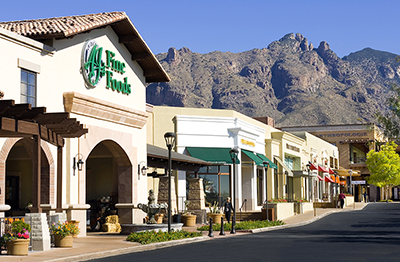
Investors Follow Shoppers to Lifestyle Centers

Image: La Encantada, a 246,250-square-foot open-air lifestyle center in Tucson, Ariz.
Investors are following shoppers as they return to lifestyle centers, said JLL, Chicago.
Increased customer foot traffic, declining vacancies coupled with growing rents and broad-based expansion plans from retailers all bolster confidence that lifestyle centers will come back strongly, JLL said.
“Leasing demand from new tenants in the market, such as digitally native brands, as well as traditional mall retailers looking for an off-mall growth strategy, are accelerating the desirability of this asset class to consumers,” said Senior Managing Director Chris Angelone, JLL Retail Co-Leader in Capital Markets. “Investors are taking notice and will seek out performance and growth potential.”
Angelone said high-performing lifestyle centers should reclaim their spot as a core asset class among investors within two to four years.
While smaller grocery-anchored retail has dominated investment demand recently, the increase in vaccinations and re-openings is motivating shoppers–and investors–to return to other retail segments. Conceived as a modern-day interpretation of the mall, lifestyle centers are known for outdoor settings and often incorporate other uses such as office, multifamily and hospitality space. They usually include upscale national chains and specialty retail with dining and entertainment.
Retail data firm Placer.ai reported the top 20 largest U.S. lifestyle centers had nearly 8.1 million visits in August, up dramatically from 1.3 million visits in April 2020 and only 7.2 percent down from August 2019.
“The lifestyle center format is attractive to retailers looking to expand, especially the retailers that survived the pandemic and are still very active in their marketplace,” said Naveen Jaggi, JLL President of Retail Advisory Services.
JLL said lifestyle centers have lower average vacancy than malls; 6.5 percent versus 6.8 percent for super-regional malls and 10 percent for regional malls. Lifestyle centers also drew 46 percent higher rents than regional malls and 11.5 percent higher rents than super-regional malls during the second quarter.
“If you look at the true quality of lifestyle centers, they performed well prior to the pandemic and are performing well again, and that is appealing to investors,” said Senior Managing Director Barry Brown, JLL Retail Co-Leader in Capital Markets. “The whispering happening now among investors might turn into cheering over the next few years, as there is the potential for huge valuation increases within the segment.”
